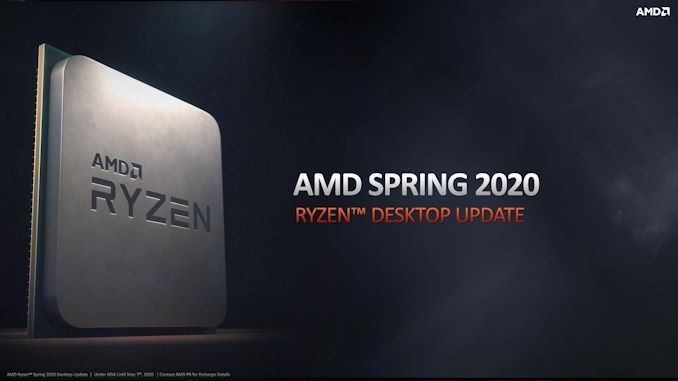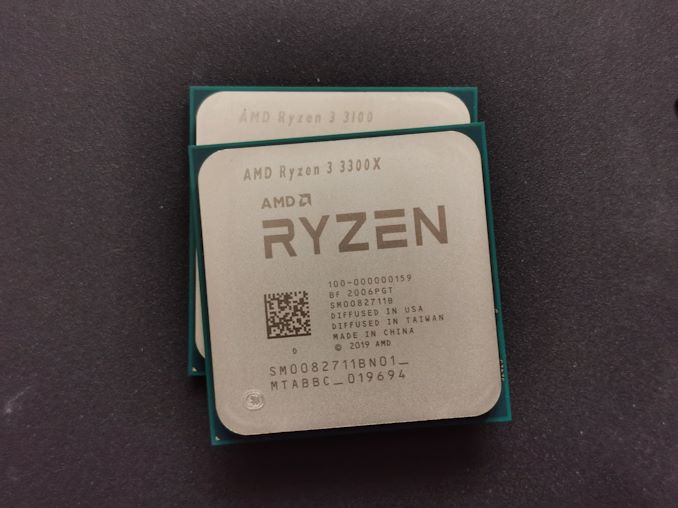The AMD Ryzen 3 3300X and 3100 CPU Review: A Budget Gaming Bonanza
by Dr. Ian Cutress on May 7, 2020 9:00 AM ESTThe Battering Ram of Time
A wouldn’t say a lot, but at least some discussion has been permeating through the airwaves since the Ryzen 3000 desktop launch as to what AMD was going to do in its sub-$200 space. Not having a latest generation product in a very active part of the market was missing from the portfolio, but initially AMD was happy for its previous generation CPUs and APUs to fill that role.
There were two schools of thought. The first is that AMD would launch lower core count CPUs, despite having a supposedly high yielding chiplet design that was going straight into its highest margin server product portfolio. Building a low core count chiplet design also incurs the added cost of bringing a chiplet and an IO die together in packaging, further decreasing margins. It seemed unlikely at the time.
The second school of thought would be that AMD would populate this part of the market with desktop versions of the Ryzen 4000 mobile APUs. These monolithic parts had integrated graphics, and would very likely easily scale from 45 W to 65 W for the desktop. Like previous APUs there would only be 8 PCIe lanes for external graphics, but for this generation also only PCIe 3.0 due to how the mobile APUs were powered.
Personally I assumed the second one, and that AMD would ignore the CPUs and go straight in for the APUs. I was perhaps unprepared for the apparent success of AMD’s mobile chips in the laptop space. We’ve reviewed the ASUS Zephyrus G14, a true flagship AMD notebook, and the Acer Swift 3, offering mind-bending performance and quality for the price. AMD is promoting 100+ design wins on Ryzen Mobile in 2020, global pandemic permitting, and the OEMs are jumping on the bandwagon it seems.
As we’ve shown in the review, this means that we get some CPUs. The Ryzen 3 3300X and Ryzen 3 3100 are odd elements to the Ryzen family, especially the 3100 with its awkward CCX and core configuration, but both parts offer a lot of performance for their pricing. At $120 and $99 respectively, using AMD’s latest Zen 2 microarchitecture and the power efficient 7nm TSMC process, AMD is defining a new baseline in budget performance.
This is personified in very much in comparing the AMD Ryzen 3 3300X to Intel’s flagship consumer processor from 2017.
Three years and four months ago at CES, Intel launched to great fanfare its Kaby Lake processor family, with the Core i7-7700K sitting atop of the stack. This quad core Skylake-based chip offered frequency bumps from the previous gen, and better gaming performance in a 91 W package. Its 4.2 GHz base frequency, 4.5 GHz turbo frequency, DDR4-2400 memory support and 16 PCIe 3.0 lanes were the talk of the down. All this could be yours for $350.
Then push forward a short time to today, and the Ryzen 3 3300X. This is also a quad core processor, built with Zen 2 cores at a lower frequency: only 3.8 GHz base and 4.3 GHz turbo. There’s faster memory in DDR4-3200, more and faster 24 PCIe 4.0 lanes, and is rated only at 65 W. For almost one third of the price, at $120.
Cue the roundup results.
| Benchmark Comparison Ryzen 3 3300X vs i7-7700K at 100% |
|||
| AnandTech | Ryzen 3 3100 |
Ryzen 3 3300X |
Core i7-7700K |
| Web | 121% | 138% | 100% |
| System | 99% | 112% | 100% |
| Encoding | 105% | 115% | 100% |
| Rendering | 98% | 111% | 100% |
| Synthetics | 103% | 110% | 100% |
| Dwarf Fortress | 86% | 95% | 100% |
| Legacy | 96% | 105% | 100% |
| Gaming | 99% | 105% | 100% |
I’m pretty sure prices of used Kaby Lake CPUs are about to crash. They’re going to have to fall a long, long way though.
It's at this time I should point out that Intel obviously has newer quad cores on offer. The 9th Generation Core i3 parts are quad core with no hyperthreading, but still running a variant of the Skylake microarchitecture, albeit at a higher frequency. The Core i3-9100 for example is a 4C/4T part with a base of 3.6 GHz and turbo of 4.2 GHz, and a TDP of 65W, for $120. It still only has PCIe 3.0 and DDR4-2400 however, so it would likely perform worse than the i7-7700K. Even with this, Intel's ability to provide enough stock of these low-end parts, depending on your location, is questionable as previously mentioned. Case in point: the comapny never even made it as far as sampling any of the 9th Generation i3 parts for review.
Intel has announced the 10th Generation Comet Lake processors, coming later this month, and the Core i3 parts there will offer hyperthreading. The Core i3-10100 is a 4C/8T part with a 3.6 GHz base and a 4.3 GHz turbo, with a 65 W TDP for $120. It still only has PCIe 3.0, but supports DDR4-2666, compared to AMD supporting PCIe 4.0 and DDR4-3200. When these are available at retail, we should put it up against the 3300X to see who wins.
All that being said, AMD still has two issues to sort out with the new Ryzen 3 parts. The idle power seems high at 18 W, and B550 motherboards need to exist to make these Ryzen 3 processors more attractive for system builds. The latter should come around soon, and we’ll have additional coverage there.
At the end of the day, if you are the sort of person that enjoys waiting a couple of years to get games 95% off on Steam, the 3300X is your processor. Those AAA titles are calling.












249 Comments
View All Comments
Spunjji - Monday, May 11, 2020 - link
The issue is that it's not informed. It's codswallop.PeterCollier - Monday, May 11, 2020 - link
You're talking about the article.Spunjji - Tuesday, May 12, 2020 - link
🤡psychobriggsy - Thursday, May 7, 2020 - link
Considering it shows the $120 AMD offering comprehensively beating the old i7-7700K, and says the current Intel budget offerings will be slower, and recommends the AMD processors, I find this comment rather brain dead.WaltC - Thursday, May 7, 2020 - link
One question I had is why AT chose to use the 2600 instead of the 3600...? Makes no sense to me, as the 3600 runs at 65W and the 3600X runs at 95W--just like the 2600--only the 3600 is appreciably faster--but costs the same! 3600 is MIA. No question but that the review benchmarks clearly demonstrate the superiority of the AMD offerings, but we already knew that. I see the omission here--deliberate--of the 3600--while including $425 Intel 6c/12t offerings--as surely an apology for Intel's inability to compete. Such is not needed, really. Apologizing in subtle ways for Intel is, I think, a pretty poor way to write a review on CPUs Intel cannot at the present time compete with--the 3100/3300. Getting right down to it--there was no need to include *any* 6c/12t CPUs here, right? Should have been comparisons only with Intel/AMD 4c/8t cpus, exclusively, imo. Selection of CPUS for *this review* didn't make any objective sense that I could see--beyond the obvious, of course (at least you didn't forget and leave the 3100/3300 out...;))evilspoons - Thursday, May 7, 2020 - link
I'm guessing the omission of the 3600X has something to do with, at the time I read this, they hadn't even finished all the benchmarks for the 3100. You know, the one in the headline. I don't think it's a conspiracy, just a time constraint.crimson117 - Thursday, May 7, 2020 - link
They didn't rerun the 2600 for this, they used existing benchmarks.They haven't ever benchmarked the 3600 previously, so it's not listed here. They do have the 3700X, however, which is essentially the same performance as a 3600 (except in heavily threaded workloads): https://www.anandtech.com/bench/product/2520?vs=25...
MDD1963 - Thursday, May 7, 2020 - link
I saw other testers on Youtube use the 3600, and, the 3300X was VERY surprisingly close to it's performance...; the 3300X's clearly quite strong threads and lack of inter -CCX -RAM latency issues are reaping benefits!BenSkywalker - Thursday, May 7, 2020 - link
The choices they use to compare are utterly bizarre. A three and a half year old Intel i7 and last generation Ryzen parts....?Legitimately, this review is useless if you are shopping *today*, not just from a team red versus team blue, but where this processor sits in today's market, no clue after reading this. One of my friends was looking for a budget gaming build and I was looking at a 3200G/B450 setup, how does this compare? Instead let's assume people have a time machine and are cross shopping two gen old Ryzen and three green old Intel parts....?
The charts aren't bad, they are terrible. Have an old i7 in there for reference, ok, put current Ryzen 3 and i3 inn there and if you don't have enough time *only* include them.
rabidpeach - Friday, May 8, 2020 - link
bro, they try to make a point with the reviews. if you want this comparison you use the cpubench feature of this website and compare any chip they tested on any of the tests they have. it's an actual feature not a bug. the point of this article and tests is to show entry level amd 100 price point is as powerful as 3 year old flagship-ish intel for the mainstream. it shows against the zen and zen+ hexacores that it catches up to them in many situations despite lacking in cores. this shows you amd is not just throwing cores at intel anymore. they have ipc too! ok any more spoon-feeding? would you prefer a spork?